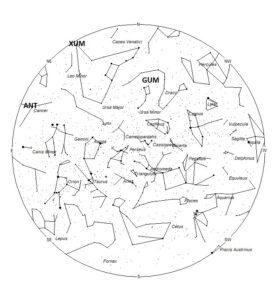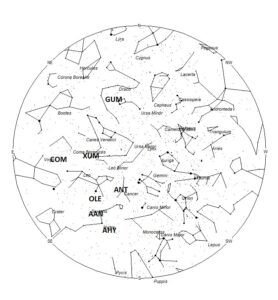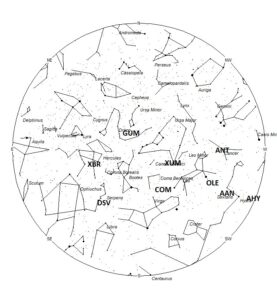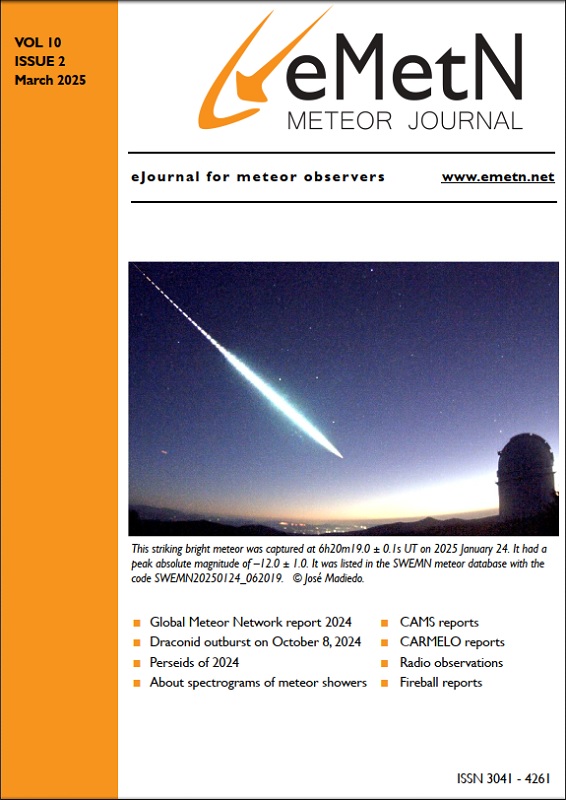During this period, the moon reaches its last quarter phase on Tuesday January 21st. At that time the moon will be located 90 degrees west of the sun and will rise between midnight and 0100 local standard time (LST) on that date. This weekend the waning gibbous moon will rise during the late evening hours and will spoil the opportunity to view meteor activity with its bright moonlight. The estimated total hourly rates for evening observers this weekend should be near 3 as seen from mid-northern latitudes (45N) and 4 as seen from tropical southern locations (25S). For morning observers, the estimated total hourly rates should be near 8 as seen from mid-northern latitudes (45N) and 8 as seen from tropical southern locations (25S). The actual rates seen will also depend on factors such as personal light and motion perception, local weather conditions, alertness, and experience in watching meteor activity. Morning rates are reduced during this period due to moonlight. Note that the hourly rates listed below are estimates as viewed from dark sky sites away from urban light sources. Observers viewing from urban areas will see less activity as only the brighter meteors will be visible from such locations.
The radiant (the area of the sky where meteors appear to shoot from) positions and rates listed below are exact for Saturday night/Sunday morning January 18/19. These positions do not change greatly day to day so the listed coordinates may be used during this entire period. Most star atlases (available online and at bookstores and planetariums) will provide maps with grid lines of the celestial coordinates so that you may find out exactly where these positions are located in the sky. I have also included charts of the sky that display the radiant positions for evening, midnight, and morning. The center of each chart is the sky directly overhead at the appropriate hour. These charts are oriented for facing south but can be used for any direction by rotating the charts to the desired direction. A planisphere or computer planetarium program is also useful in showing the sky at any time of night on any date of the year. Activity from each radiant is best seen when it is positioned highest in the sky, either due north or south along the meridian, depending on your latitude. Radiants that rise after midnight will not reach their highest point in the sky until daylight. For these radiants, it is best to view them during the last few hours before dawn. It must be remembered that meteor activity is rarely seen at its radiant position. Rather they shoot outwards from the radiant, so it is best to center your field of view so that the radiant lies toward the edge and not the center. Viewing there will allow you to easily trace the path of each meteor back to the radiant (if it is a shower member) or in another direction if it is sporadic. Meteor activity is not seen from radiants that are located far below the horizon. The positions below are listed in a west to east manner in order of right ascension (celestial longitude). The positions listed first are located further west therefore are accessible earlier in the night while those listed further down the list rise later in the night.

Radiant Positions at 18:00 LST

Radiant Positions at Midnight LST

Radiant Positions at 0600 LST
These sources of meteoric activity are expected to be active this week
.
The large Anthelion (ANT) radiant is currently centered at 08:44 (131) +18. This position lies in central Cancer, near the spot occupied by the 4th magnitude star known as Asellus Australis (delta Cancri). This radiant is best placed near 01:00 local standard time (LST) when it lies on the meridian and is highest in the southern sky. Rates at this time should be near 2 per hour as seen from the northern hemisphere and 1 per hour as seen from south of the equator. With an entry velocity of 30 km/sec., the average Anthelion meteor would be of slow velocity.
The last of the alpha Hydrids (AHY) are expected from 09:08 (137) -11. This position lies in western Hydra, 4 degrees southwest of the 2nd magnitude star known as Alphard (alpha Hydrae). These meteors are best seen near 0200 LST when the radiant lies highest above the southern horizon. At 42 km/sec. the alpha Hydrids produce meteors of medium velocity. Expected rates this week are less than 1 per hour no matter your location.
The alpha Antliids (AAN) were discovered by D. P. Galligan and W. J. Baggaley by using the Advanced Meteor Orbit Radar in New Zealand*. This very weak display is active from January 22 through February 6 with maximum activity occurring on February 1st. The radiant currently lies at 09:46 (146) -04. This position lies in western Sextans, 5 degrees northeast of the 2nd magnitude star known as Alphard (alpha Hydrae). I’m not certain why these meteors were called alpha Antliids as this position lies 20 degrees north of the constellation of Antlia. These meteors are best seen near 0200 LST when the radiant lies highest above the southern horizon. At 44 km/sec. the alpha Antliids produce meteors of medium velocity. Expected rates this week are less than 1 per hour no matter your location.
*Gary Kronk, Meteor Showers-An Annotated Catalog, 2nd Edition Page 45
The omicron Leonids (OLE) were discovered by Damir Šegon and the Croatian Meteor Network team based on studying SonotaCo and CMN observations (SonotaCo 2007-2011, CMN 2007-2010). These meteors are active from December 20 through January 22. Maximum activity occurs on January 8th. The radiant is currently located at 09:48 (147) +08. This position lies in southwestern Leo, 4 degrees southwest of the 1st magnitude star known as Regulus (alpha Leonis). These meteors are best seen near 0200 LST when the radiant lies highest above the southern horizon. At 43 km/sec. the omicron Leonids produce meteors of medium velocity. Expected rates this week are less than 1 per hour no matter your location. These meteors are also known as the kappa Cancrids.
The January xi Ursae Majorids (XUM) were discovered by Japanese observers of SonotoCo based on video observations in 2007-2008. This shower is active from January 10-25, with maximum activity occurring on the 19th. The radiant is currently located at 11:18 (170) +32, which lies in southern Ursa Major, near the spot occupied by the 4th magnitude star known as Alula Australis (xi Ursae Majoris). These meteors are best seen near 03:00 LST when the radiant lies highest in the northern sky. Hourly rates are expected to be less than one per hour no matter your location. These meteors encounter the atmosphere at 41 km/sec., which would produce meteors of medium velocity.
The Comae Berenicids (COM) are a long duration shower active from December 5th through February 4th. Maximum activity occurred on December 19th. The radiant is currently located at 12:32 (188) +17, which places it in southern Coma Berenices, 2 degrees southwest of the faint star known as 24 Comae Berenices. These meteors would be best seen near 05:00 LST, when the radiant lies highest in the southern sky. Current rates should be near 1 per hour as seen from the northern hemisphere and less than 1 as seen from south of the equator. At 63km/sec., these meteors would produce mostly swift meteors.
The gamma Ursae Minorids (GUM) were discovered by Dr. Peter Brown and associates. These meteors are active from January 15-25, with maximum activity occurring near January 19. The radiant is currently located at 15:15 (230) +67, which places it southern Ursa Minor, 5 degrees south of the 3rd magnitude star known as Pherkad (gamma Ursae Minoris). These meteors are best seen during the last few hours before dawn, when the radiant lies highest in a dark sky. Current rates are expected to be near 1 per hour as see from the northern hemisphere and less than on as seen from south of the equator. These meteors encounter the atmosphere at 30 km/sec., which would produce meteors of medium-slow velocity.
The December sigma Virginids (DSV) is a source of long duration discovered by John Greaves using the data from SonotaCo. This source is active from November 26 through January 24 with peak rates occurring near December 21st. The current radiant location is at 15:24 (231) -00, which places it in southern Serpens Caput, 5 degrees northwest of the 4th magnitude star known as mu Serpentis. Current hourly rates would be less than 1 no matter your location. These meteors are best seen during the last dark hour before dawn, when the radiant lies highest above the southern horizon in a dark sky. At 66 km/sec. the December Sigma Virginids would produce mostly swift meteors.
The xi Coronae Borealids (XCB) were another shower discovered by Dr. Peter Brown and associates. These meteors are active from January 9-20 with maximum occurring near January 15. The radiant is currently located near 16:53 (253) +29, which actually places it in central Hercules, 3 degrees southeast of the 3rd magnitude star known as zeta Herculis. Hourly rates would be less than 1 per hour no matter your location. These meteors are best seen during the last hour before dawn, when the radiant lies highest above the eastern horizon in a dark sky. At 46 km/sec. this source would produce meteors of medium velocity. These meteors are not well seen from the Southern Hemisphere as the radiant lies low in the northeastern sky at dawn.
Sporadic meteors are those meteors that cannot be associated with any known meteor shower. All meteor showers are evolving and disperse over time to the point where they are no longer recognizable. Away from the peaks of the major annual showers, these sporadic meteors make up the bulk of the activity seen each night. As seen from the mid-Northern Hemisphere (45N), one would expect to see during this period approximately 5 sporadic meteors per hour during the last hour before dawn as seen from rural observing sites. Evening rates would be near 2 per hour. As seen from the tropical Southern latitudes (25S), morning rates would be near 7 per hour as seen from rural observing sites and 3 per hour during the evening hours. Locations between these two extremes would see activity between these listed figures. Morning rates are reduced due to moonlight.
The list below offers the information in tabular form of the showers that I feel are within reach of the visual observer to discern. Hourly rates are often less than one, so these sources are rarely listed as visual targets in most meteor shower lists. If you are like me and wish to associate as many meteors as possible with known sources, then you will appreciate these listings. Before listing meteors from these obscure sources, you should attempt to prove these meteors belong to them and are not chance alignments of sporadic meteors. You can note parameters such as duration, length, radiant distance and the elevation of each meteor to help compute the probability of shower association. It should be remembered that slow meteors can be seen from fast showers, but fast meteors cannot be produced from slow showers. Slower showers are those with velocities less than 35/km per second. Slow meteors can appear from fast showers when they appear close to the radiant or low in the sky. The table located on page 22 of the IMO’s 2025 Meteor Shower Calendar is a big help in aiding in the identification of meteors. If you record the length and duration of each meteor, you can use this chart to check the probability of the meteor belonging to a shower of known velocity. If the angular velocity is similar to the figure in the table, then your meteor probably belongs to that shower. Rates and positions are exact for Saturday night/Sunday morning.
| SHOWER | DATE OF MAXIMUM ACTIVITY | CELESTIAL POSITION | ENTRY VELOCITY | CULMINATION | HOURLY RATE | CLASS |
| RA (RA in Deg.) DEC | Km/Sec | Local Standard Time | North-South | |||
| Anthelion (ANT) | – | 08:44 (131) +18 | 30 | 01:00 | 2 – 1 | II |
| alpha Hydrids (AHY) | Jan 05 | 09:08 (137) -11 | 42 | 02:00 | <1 – <1 | II |
| alpha Antliids (AAN) | Feb 01 | 09:46 (146) -04 | 44 | 02:00 | <1 – <1 | IV |
| omicron Leonids (OLE) | Jan 08 | 09:48 (147) +08 | 43 | 02:00 | <1 – <1 | IV |
| January xi Ursae Majorids (XUM) | Jan 18 | 11:18 (170) +32 | 41 | 04:00 | <1 – <1 | IV |
| Comae Berenicids (COM) | Dec 19 | 12:32 (188) +17 | 63 | 05:00 | 1 – <1 | II |
| gamma Ursae Minorids (GUM) | Jan 19 | 15:15 (230) +67 | 29 | 08:00 | 1 – <1 | IV |
| December sigma Virginids (DSV) | Dec 23 | 15:24 (231) -00 | 66 | 08:00 | <1 – <1 | IV |
| xi Coronae Borealids (XBR) | Jan 15 | 16:53 (253) +29 | 46 | 10:00 | <1 – <1 | IV |
You can keep track of the activity of these meteor showers as well as those beyond the limits of visual observing by visiting the NASA Meteor Shower Portal. You can move the sky globe to see different areas of the sky. Colored dots indicate shower meteors while white dots indicate sporadic (random) activity. The large orange disk indicates the position of the sun so little activity will be seen in that area of the sky.
Class Explanation: A scale to group meteor showers by their intensity:
- Class I: the strongest annual showers with Zenith Hourly Rates normally ten or better.
- Class II: reliable minor showers with ZHR’s normally two to ten.
- Class III: showers that do not provide annual activity. These showers are rarely active yet have the potential to produce a major display on occasion.
- Class IV: weak minor showers with ZHR’s rarely exceeding two. The study of these showers is best left to experienced observers who use plotting and angular velocity estimates to determine shower association. These weak showers are also good targets for video and photographic work. Observers with less experience are urged to limit their shower associations to showers with a rating of I to III.

